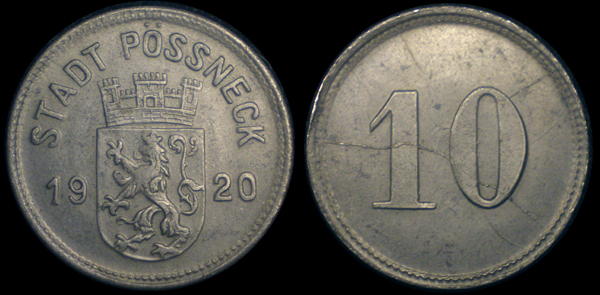
STADT PÖSSNECK (GERMAN) 10 PFENNIG 1920
L- 415.4 City of Pössneck (Thuringia) Iron 10 Pfennig Coin Depicting Town Coat of Arms.
This iron 10 pfennig coin (with a die crack) was issued by the City of Pössneck and depicts the city coat of arms. Coins like this one were common and meant to be used as small change.
Pössneck is a city located in Germany, presently in the state of Thuringia and the district of Saale-Orla-Kreis. Before merging with Thuringia in 1920 the town was a part of the Free State of Saxe-Meiningen. First mentioned in 1252, it is Slavonic in origin and became a part of the landgrave of Thuringia in 1300. It passed to Saxony and then to Saxe-Coburg-Saalfeld before becoming a part of the Duchy of Saxe-Meiningen in 1826.
In its history it has fallen victim to plague in 1625, faced looting and other indignities during the 30 years war, and it was host to the writer Goethe numerous times between 1795 and 1823. It also has been host to a hostile Napoleon who pillaged the town in 1806.
By 1667 the town was home to more than 90 clothiers and 21 tanners. These businesses have thrived in the town since the 16th century and was the source of the early towns wealth and reputation. In the later 19th and early 20th centuries Pössneck became the most industrialized town in the Duchy of Saxe-Meiningen with a thriving textile industry as well as a patent leather works and a chocolate factory. Pössneck is also well known as a printing/publishing hub.
Today the towns chief industries are the making of flannel, porcelain, furniture, machines, musical instruments and chocolate. The town is also home to tanneries, breweries, dyeworks and brickworks. After World War II and the partitioning of Germany, Pössneck became a part of the GDR until reunification in 1990.
